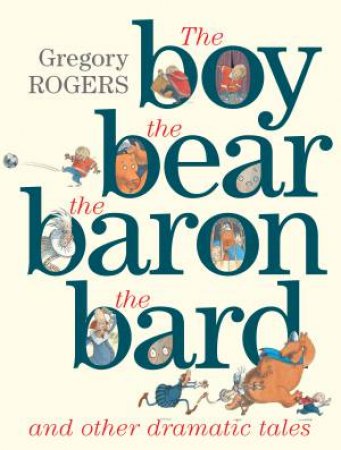This compendium of three books by Gregory Rogers was released two years after his death. The Boy, the Bear, the Baron, the Bard, first published in 2004 as a brightly coloured graphic-narrative-without-text, became a worldwide phenomenon, short-listed for the Children’s Book Council Awards, the New York Times Best Illustrated Books, APA Book Design Award, Aurealis Award, American Library Association Book of the Year and other awards.
Gregory Rogers was already a celebrated graphic designer when he ventured into a self-authored tale that took wings from his personal passion — all things Elizabethan. When he read in his research that Shakespeare’s plays were scheduled to be performed at 4 o’clock in the afternoon he had the key to his little boy’s time travelling experience. His tiny boy in tights and cape goes through a heavy curtain in an abandoned warehouse in modern London into Elizabethan London where he disrupts one of the bard’s plays so annoyingly that the playwright feels compelled to chase him through the streets. Linking up with an escaped performing bear, the boy and bear go through a dark archway, and on into a corridor leading to a dungeon where they team up with an imprisoned baron. After adventures on the Thames, they leave the baron with a baroness, the bear leaves the boy on the shore, and the boy is chased by the bard back to the twenty-first century. There are small comic-book-style windows into the action along with full-page panoramas of Elizabethan London, and a final moment as the boy looks back at us, sorry to have come to the end of his tale but glad to be free of the vengeful bard. Such wordless storytelling is of course deeply embedded in language, for the story absorbed visually can only be shared in words between its ‘readers.’ This kind of book is a gift to anyone wanting to bring stories to life through spoken words. It is a gift too for the child daunted by text but interested in what books have to offer.
The following stories, Midsummer Knight and The Hero of Little Street continue to follow the adventures of the cheeky, lively, rotund and expressive little boy. Midsummer takes its inspiration from Shakespeare’s A Midsummer Night’s Dream, offering a world of fairies, forests, treasures and castles, featuring the return of the performing bear, the re-appearance of the little boy as a winged fairy, and the bard as a dangerous bumble-bee figure scheming to thieve the treasures of a castle. After rescuing the baron and baroness, the treasure and the castle, the boy and the bear enter the long corridor of a mighty hollow tree root, leading them back to their home territories. It is a beautiful sequel to the first volume, just as lively, and just as full of potential for telling its story in spoken words while thrilling to it in images.
The final story adopts the figure of the little boy again, but this time more whimsically and more knowingly. He is of course chased, as he always is, but this time he is chased into fine art works by Vermeer and Van Eyck at the National Gallery of London. Gregory Rogers indulges his love of art and dogs as he takes the chase into ‘The Little Street’ of Vermeer and on through seventeenth-century Delft among gangs of street dogs where a butcher suspiciously like the bard almost nets the boy. Again, the images are sometimes small and fine and sometimes sweepingly dramatic, filling their page. Gregory Rogers knew how to make a past world look full of life. His work fits superbly into the growing interest in the graphic narrative while not adhering to any of the common genres of this form. His work unmistakeably comes from a lively personal imagination.

